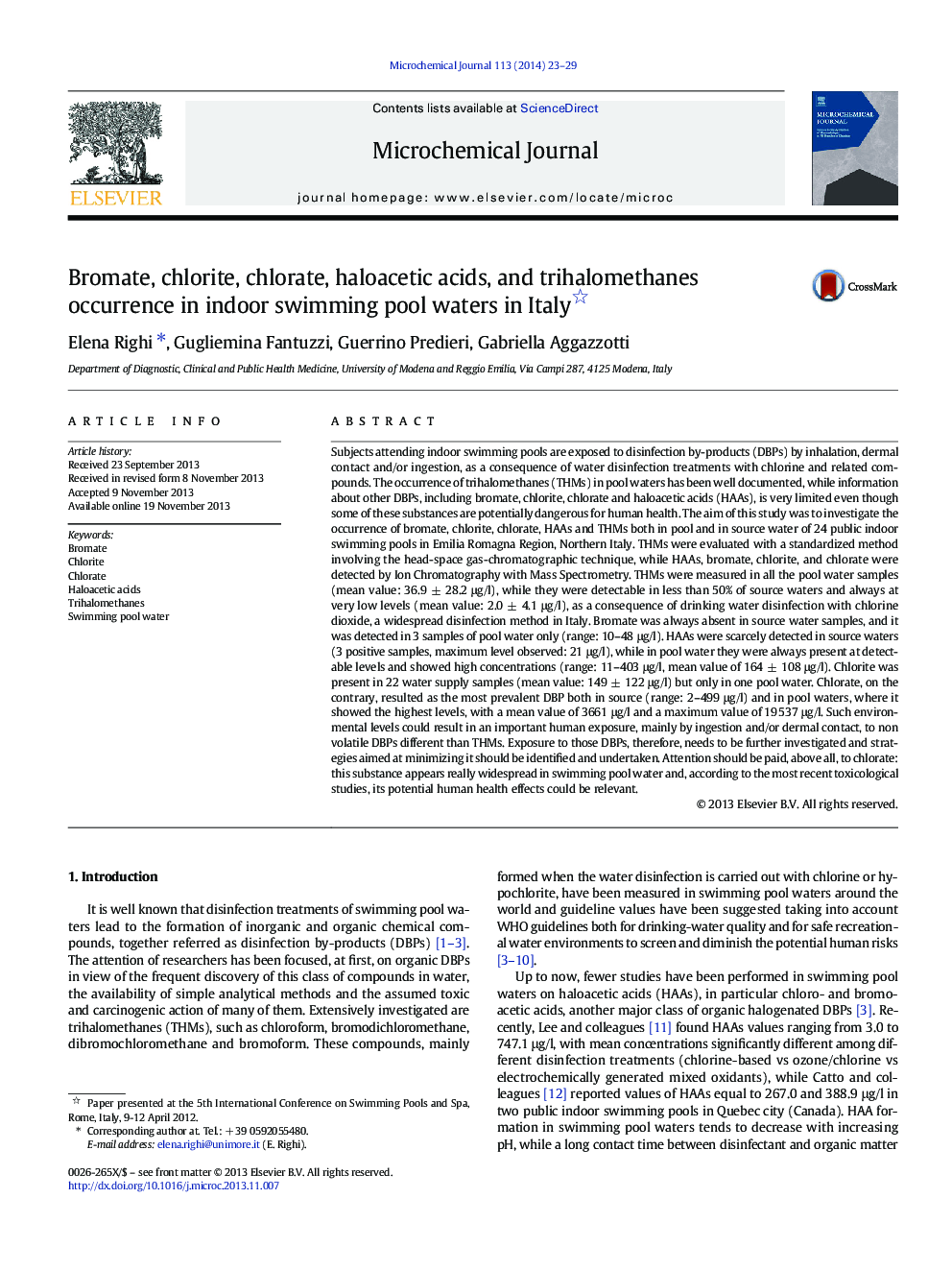| کد مقاله | کد نشریه | سال انتشار | مقاله انگلیسی | نسخه تمام متن |
|---|---|---|---|---|
| 7643146 | 1494881 | 2014 | 7 صفحه PDF | دانلود رایگان |
عنوان انگلیسی مقاله ISI
Bromate, chlorite, chlorate, haloacetic acids, and trihalomethanes occurrence in indoor swimming pool waters in Italy
دانلود مقاله + سفارش ترجمه
دانلود مقاله ISI انگلیسی
رایگان برای ایرانیان
کلمات کلیدی
موضوعات مرتبط
مهندسی و علوم پایه
شیمی
شیمی آنالیزی یا شیمی تجزیه
پیش نمایش صفحه اول مقاله

چکیده انگلیسی
Subjects attending indoor swimming pools are exposed to disinfection by-products (DBPs) by inhalation, dermal contact and/or ingestion, as a consequence of water disinfection treatments with chlorine and related compounds. The occurrence of trihalomethanes (THMs) in pool waters has been well documented, while information about other DBPs, including bromate, chlorite, chlorate and haloacetic acids (HAAs), is very limited even though some of these substances are potentially dangerous for human health. The aim of this study was to investigate the occurrence of bromate, chlorite, chlorate, HAAs and THMs both in pool and in source water of 24 public indoor swimming pools in Emilia Romagna Region, Northern Italy. THMs were evaluated with a standardized method involving the head-space gas-chromatographic technique, while HAAs, bromate, chlorite, and chlorate were detected by Ion Chromatography with Mass Spectrometry. THMs were measured in all the pool water samples (mean value: 36.9 ± 28.2 μg/l), while they were detectable in less than 50% of source waters and always at very low levels (mean value: 2.0 ± 4.1 μg/l), as a consequence of drinking water disinfection with chlorine dioxide, a widespread disinfection method in Italy. Bromate was always absent in source water samples, and it was detected in 3 samples of pool water only (range: 10-48 μg/l). HAAs were scarcely detected in source waters (3 positive samples, maximum level observed: 21 μg/l), while in pool water they were always present at detectable levels and showed high concentrations (range: 11-403 μg/l, mean value of 164 ± 108 μg/l). Chlorite was present in 22 water supply samples (mean value: 149 ± 122 μg/l) but only in one pool water. Chlorate, on the contrary, resulted as the most prevalent DBP both in source (range: 2-499 μg/l) and in pool waters, where it showed the highest levels, with a mean value of 3661 μg/l and a maximum value of 19 537 μg/l. Such environmental levels could result in an important human exposure, mainly by ingestion and/or dermal contact, to non volatile DBPs different than THMs. Exposure to those DBPs, therefore, needs to be further investigated and strategies aimed at minimizing it should be identified and undertaken. Attention should be paid, above all, to chlorate: this substance appears really widespread in swimming pool water and, according to the most recent toxicological studies, its potential human health effects could be relevant.
ناشر
Database: Elsevier - ScienceDirect (ساینس دایرکت)
Journal: Microchemical Journal - Volume 113, March 2014, Pages 23-29
Journal: Microchemical Journal - Volume 113, March 2014, Pages 23-29
نویسندگان
Elena Righi, Gugliemina Fantuzzi, Guerrino Predieri, Gabriella Aggazzotti,